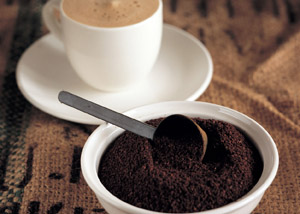Introduction to the Grinding Calibration Manor of the Regional treatment method for the Variety characteristics of Coffee beans in Rwanda
Rwandan coffee is mostly washed. The washing method first washes and floats the ripe coffee fruit, then removes the exocarp, pulp and part of the pectin layer, then sends the coffee to the fermentation tank, ferments the remaining pectin layer and sends it to the drying field for drying treatment, so that the moisture content reaches about 13%. The coffee in the above picture is placed on the African shed for drying to avoid the coffee contaminated with soil. The ventilation effect is better during drying to avoid mildew. During the drying process, coffee farmers will also turn the beans regularly to make the drying more uniform, and at the same time will select the beans with poor quality and discard them.
Rwanda's flavor, ashamed of the bias that initially appeared in Rwanda's perception. I remember when I first came into contact with coffee, carrying out olfactory training was very resistant to No.3 in the 36-scent bottle, and even felt like vomiting when I smelled it. Therefore, subjectively, I always like to make up the taste of grass for the smell of green peas. Due to lack of experience in tasting and making, they will subjectively list Rwanda's grassy, lavender-like aroma as their own conflicting flavor. So when Rwanda is made and smells its characteristic lavender scent, the coffee bug retracts back into its stomach. However, with the improvement of tasting and production experience, there is a new understanding of Rwanda with its unique aroma.
Before sharing this article with you, in order to have a more objective evaluation of Rwanda, I have specially evaluated it by cup test. Well-roasted and washed Rwanda with nutty aromas of roasted peanuts, spice and wood. Wet lavender, grass aroma strong, temperature drops a little after the fruit-like sweetness increases, lavender flavor decreases. Clean and mellow taste, good aftertaste, persistent aroma. The acidity is softer, and the overall feeling is full and stretched.
Rwandan coffee is attracting attention for its high-quality washed Arabica beans and is gaining increasing popularity in international markets. Rwanda plans to export 3000 tonnes of coffee this year, further boosting production to meet increasing demand, according to marketing and promotion officer of the Rwanda Coffee Association, Karuretwa. Starbucks, the world's largest coffee retailer, has partnered with the Rwandan government to import Rwandan coffee, just as a coffee-colored dove flies from a coffee cup against the words "Cup of Hope" on the Rwandan coffee label. Indeed, coffee holds the hopes of the Rwandan people. They hope to increase coffee exports to drive the country's economic development, but also hope that Hutu and Tutsi, the two major tribes that once hated each other, will work together to grow coffee and eliminate hatred and build a better tomorrow.

Important Notice :
前街咖啡 FrontStreet Coffee has moved to new addredd:
FrontStreet Coffee Address: 315,Donghua East Road,GuangZhou
Tel:020 38364473
- Prev

Introduction of Colombian Coffee Bean Variety characteristics Regional treatment Grinding Calibration Manor
The country's coffee-producing areas are located in the Andes, where the climate is mild and the air is humid. Colombia has three Codiera mountains running north and south, right into the Andes. Coffee is grown along the highlands of these mountains. The mountain steps provide a diverse climate, where the whole year is the harvest season, and different kinds of coffee ripen at different times. And fortunately, Columby
- Next

Introduction to the characteristic treatment method of Puerto Rico coffee bean flavor description grinding scale
Apart from the sunshine and beaches of the Caribbean and Miss World, do you know what else is most attractive about this South American island known as the port of wealth? That's the best coffee. Puerto Rico is one of the world's preeminent coffee producers. Since the second half of the 19th century, Puerto Rican coffee has become the first choice of the Vatican and European royals, and has also been the president of the United States.
Related
- Detailed explanation of Jadeite planting Land in Panamanian Jadeite Manor introduction to the grading system of Jadeite competitive bidding, Red bid, Green bid and Rose Summer
- Story of Coffee planting in Brenka region of Costa Rica Stonehenge Manor anaerobic heavy honey treatment of flavor mouth
- What's on the barrel of Blue Mountain Coffee beans?
- Can American coffee also pull flowers? How to use hot American style to pull out a good-looking pattern?
- Can you make a cold extract with coffee beans? What is the right proportion for cold-extracted coffee formula?
- Indonesian PWN Gold Mandrine Coffee Origin Features Flavor How to Chong? Mandolin coffee is American.
- A brief introduction to the flavor characteristics of Brazilian yellow bourbon coffee beans
- What is the effect of different water quality on the flavor of cold-extracted coffee? What kind of water is best for brewing coffee?
- Why do you think of Rose Summer whenever you mention Panamanian coffee?
- Introduction to the characteristics of authentic blue mountain coffee bean producing areas? What is the CIB Coffee Authority in Jamaica?

